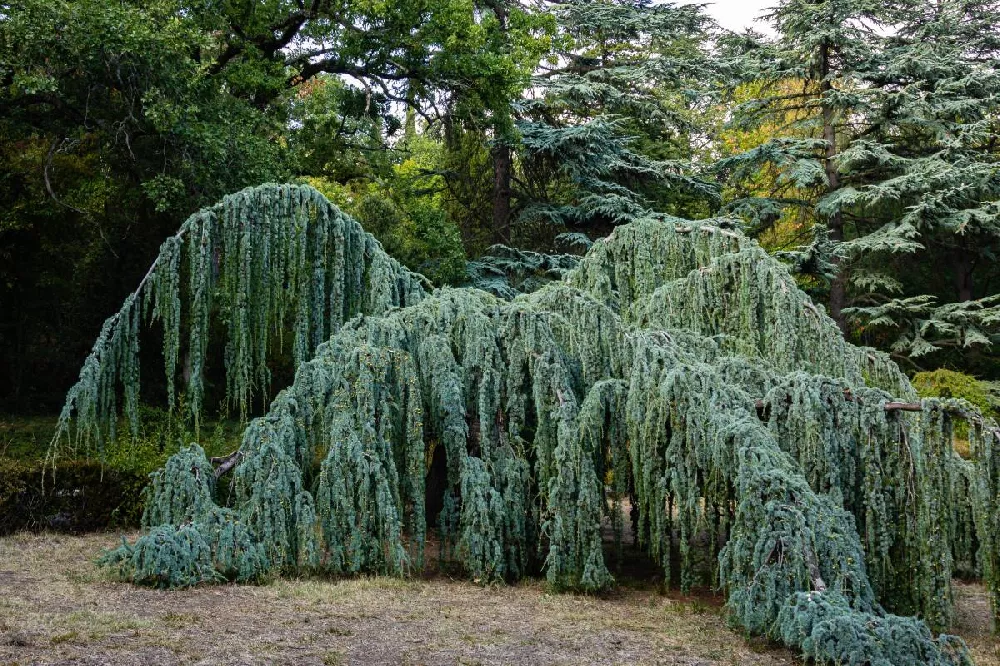- Home >
- Evergreen Trees >
- Weeping Blue Atlas Cedar Tree
Weeping Blue Atlas Cedar Tree for Sale - Buying & Growing Guide
Once you encounter a weeping blue atlas cedar tree, you will never again make the mistake of assuming evergreens add nothing more than background greenery. By contrast, this plant, Cedrus atlantica 'Glauca Pendula,' can stand out from nearly every other plant in your garden with its dramatic weeping branches. As this tree continues to develop, its main trunk and branches become all the more twisted and interesting. All year, the weeping blue atlas cedar tree provides foliage that is surprisingly bright and slightly blue.
- As the name suggests, this plant has an amazing weeping form.
- This plant's evergreen foliage is bright with a slight blue tint.
- The form of this tree becomes more twisted and intricate with age.
Enter your zip code to find nearby stores that may carry this plant.
Plant Care
Sunlight

The weeping blue atlas cedar tree survives in partial shade but grows best in full sunlight.
Watering
Water this plant with about 1 inch of water each week during the hottest months of the growing season.
Fertilizing

Apply a nitrogen-rich fertilizer about once every other year during the early spring.
Planting and Care
Planting instructions
Although a weeping blue atlas cedar tree will survive in partial shade, it will perform best when it receives at least 6 hours of light per day. This plant will also grow best in soils that are deep, loamy and acidic. However, it is possible for this plant to grow in soils of any acidity level. To plant this tree, dig a hole that is as deep as the root ball is tall and about twice as wide.
Watering and nutrients
A well-established weeping blue atlas cedar tree will have great drought tolerance, which means you will need to water it only during the hottest parts of each growing season. During the height of summer, it’s best to give this plant about one inch of water per week, but it will often survive off of less water than that. You can feed your weeping blue atlas cedar tree once every year or two years using a nitrogen-rich fertilizer.
Pollination
A single weeping blue atlas cedar tree will carry both male and female cones. The male cones are a few inches long and tend to form clusters. These cones release large quantities of yellow pollen, which travels via the wind to allow pollination to take place. The weeping blue atlas cedar tree is a self-pollinating species. However, pollination is not a common goal for those who grow this plant as it does not produce an edible harvest.
Pruning
You should prune your weeping blue atlas cedar tree during the early spring just before the new growth emerges. As you prune, you should focus on removing any dead, damaged or diseased limbs. However, you won’t need to do too much shaping as this tree’s form is quite irregular but appealing by nature. The slow growth of this tree also means you won’t need to use pruning to control its spread. Any time you prune your weeping blue atlas cedar tree, you should not remove more than one-third of the plant’s total mass.
Pests, diseases and animals
Overall, the weeping blue atlas cedar tree is a problem-free plant that will be easy to keep healthy throughout its life. Part of the reason for that ease of maintenance is that the weeping blue atlas cedar tree has a fantastic ability to ward off both pests and diseases. On rare occasions, this tree may experience browning foliage, often caused by rot or spider mites. However, any issues related to pests and diseases remain quite unlikely.
Achieving maximum results
Take time when selecting a growing location for your weeping blue atlas cedar tree. While this plant is not too picky about where it grows, it does not typically respond well to transplanting, meaning that you should pick a suitable growing location from the start. Also, your weeping blue atlas cedar tree can benefit from some wind protection as strong prolonged gusts can damage this plant’s hanging branches. However, beyond those two considerations, the weeping blue atlas cedar tree has very few specific maintenance needs.
FAQs
Where does the weeping blue atlas cedar tree come from?
The parent species of the weeping blue atlas cedar tree is known simply as the atlas cedar or Cedrus atlantica. This species hails from the Atlas mountains, which span parts of Morocco and Algeria. The plant called weeping blue atlas cedar tree is a cultivated version of the atlas cedar that came into existence relatively recently. Unlike this cultivar, the original atlas cedar has less of a weeping form and is more upright in its branching habit.
Does the weeping blue atlas cedar tree require a lot of maintenance?
One of the greatest benefits of growing the blue atlas cedar tree is that this plant does not require a lot of maintenance to survive. For instance, this plant needs very little water and fertilizer when mature. It is also resistant to many common garden pests and diseases. Along with that, the weeping blue atlas cedar tree is a slow-growing plant, which means it will not overtake your garden.
What is the best way to use a weeping blue atlas cedar tree in the garden?
If you choose to grow a weeping blue atlas cedar tree, you should treat it as a specimen plant. The growth habit of this plant alone prevents it from fading into the background of your planting scheme. Plant this tree where it can have some space to expand and achieve its most attractive form. The weeping blue atlas cedar tree also works well in zen gardens.
Compare Similar Products
You can't add more Product Name - Product size to the cart.
OK








